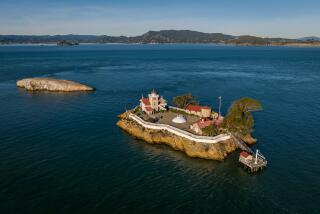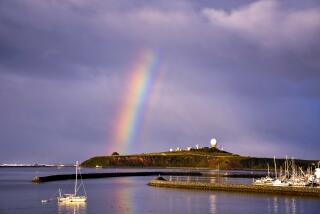DESTINATION / HONG KONG : A World Away : Little Lamma Island, a 40-Minute Ferry Ride From Hong Kong, Offers a Rural Respite From the Crowds
HONG KONG — Most of Hong Kong’s 6 million inhabitants are packed onto a section of Hong Kong Island and Kowloon Peninsula. Pushing through the crowds on Nathan Road or in the teeming markets of Mongkok, the city’s density is all too palpable. But take a ferry to one of Hong Kong’s 235 outlying islands, and you can escape a world of high-rises and flyovers in less than an hour.
Lamma is one of the closest islands to the city, only 40 minutes away by ferry from Hong Kong’s Central District. Its open-air seafood restaurants on the waterfront are famous for the freshest prawns, lobster and other delicacies--at prices about a third less than Hong Kong’s. The largely rural, five-square-mile island attracts a sizable contingent of Hong Kong day-trippers, particularly on summer weekends.
But when I visited on a quiet autumn weekday, I was searching for serenity, not seafood. Private cars are prohibited on Lamma, and I was looking forward to a relaxing hike along its gentle, grassy hills and deserted beaches.
I disembarked at Yung Shue Wan, one of two Lamma villages served by the Hong Kong Ferry, with several commuters returning home from work. (Most of the island’s 5,000 residents are fishermen, but it has also drawn former Hong Kong residents fleeing the city’s congestion.)
Following the commuters’ lead and my map, I walked 20 or 30 minutes to a small crescent of almost-white sand, at this hour echoed by the crescent moon just visible in the western sky above the bay.
Straight up the steep hill overlooking Hung Shing Ye Beach, I saw a red-and-white sign advertising, in Chinese characters, Han Lok Yuen, one of several small, unpretentious “holiday houses” that cater to weekend visitors from Hong Kong. I climbed a broken flight of cement steps to a scarlet-painted iron gate, beyond which was a terrace dotted with umbrella-topped tables and surrounded by palm trees and potted plants.
My corner room on the third and top floor, with a tiny bathroom whose shower produced a weak jet of warmish water, was simple in the extreme. But its very simplicity set off the beauty of the scene outside. I carefully averted my eyes from the large power plant directly to the west (whose twin stacks are visible as far away as Hong Kong). But to the east, against a backdrop of brown hills, banana trees with broad, tattered leaves fluttered in the wind. Red and purple bougainvillea crowded the windows. And on the bay side, green bamboo at least 30 feet high pushed through my balcony’s crimson railings, and the indigo South China Sea lay beyond.
The restaurant at the Han Lok Yuen is famous for its roast pigeon, and securing a table at dinner (especially for one or two people, since most tables seat 8 or 10) can be difficult. I managed to get a seat on the terrace at sunset and asked for their signature dish. “Why don’t you have it tomorrow,” my waiter suggested.
“I’m going back to the city tomorrow,” I replied.
“Well, if you don’t mind waiting a long time . . . .”
I didn’t--but learned to order in advance the next time. When my pigeon finally arrived, spread-eagle on its white plate, it was crisp and luscious . . . not really roasted at all, but simmered first in a richly spiced broth, then deep-fried to seal in the juices and give the skin a glossy crunch.
The following morning, I set out on what I had planned as an all-day hike to some of Lamma’s more remote beaches and up 1,158-foot Shan Tei Tong (Mt. Stenhouse), the island’s highest vantage point. I was prepared for at least a few wrong turns. In more populated parts of the island, footpaths are often paved and clearly marked in English. But once you pass beyond the larger settlements, they are neither maintained nor marked.
The path that began below my hotel, just off Hung Shing Ye Beach, bumped up and down along low and windy cliffs above stony beaches and sheer drops to the sea. Dragonflies and blue, black and white butterflies darted in and out of the tall grasses. Already a hot-looking haze hung over the peak in front of me--making me glad I’d chosen to explore Lamma in autumn, when temperatures are often at least 10 degrees cooler than on a sticky midsummer’s day.
From the island’s isthmus near Lo So Shing Beach, the little fishing port of Sok Kwu Wan was shining in the sun, the wind rippling the water to a fine glitter. Dozens, maybe hundreds, of small boats and pontoons topped by little shacks painted pink and green formed a floating bridge almost all the way across the harbor.
A red-brick and whitewashed-cement-block building with scarlet doors stood open to the breeze on the outskirts of the village. Inside, cramming the narrow aisles of the Tin Hau temple (dedicated to the Taoist queen of heaven and goddess of the sea), I saw a horned beast’s head of papier-mache and red plush and two shrines encrusted with paper deities, dragons and red, green and blue flowers. Gold-and-white lanterns with silky red tassels hung suspended from the ceiling. An open window on Sok Kwu Wan’s main street revealed a small room full of older women, lustily playing mah-jongg with much clacking of tiles. Along the waterfront, shops and restaurants were just opening up. At one establishment, the kitchen staff sat around a table outside, eating richly flavored sticky rice wrapped in lotus leaves, a snack that looked so tempting I bought one as sustenance for my journey. Following a cement path along the coast to the east, I bypassed the turnoff to the beach at Mo Tat Wan and headed directly for the village of Mo Tat, a cluster of houses and banana groves. Near laundry poles sporting sets of black pajamas in front of traditional, tile-roofed stone houses, a man was doing his washing at a communal spigot.
Past the cluster of houses and banana groves that make up Mo Tat, the path led under cover, and tiny sapphire butterflies darted in and out of the shade.
From another nearby village called Tung O--where two tattered red rags tied to a bamboo pole marked the entrance, reminiscent of a Chinese landscape painting--I took an unmarked, yellow dirt path up the northeast ridge of Shan Tei Tong. As I climbed, I looked down the mountain’s steep eastern slope to the lapis lazuli waters and white-sand beach at Sham Wan. About halfway up, the path became steep steps cut into the sandy soil by the feet of earlier climbers--a graphic reminder that the trail is recommended for experienced hikers, and only when the visibility is good.
At the summit, crickets chirped faintly in the sharp wind, amid grass and pale purple thistle. The skyscrapers of Hong Kong Island and the cement works at Sok Kwu Wan prevented some of the isolation I seek on mountaintops, but the views across the water were breathtaking, the gray shapes of neighboring Lantau’s peaks suggesting another expedition.
The northwest descent from the peak to Lo So Shing Beach, along a gently undulating ridge with a view of the water, looked more gradual and less fearsome than the way I came up. But the final segment of the trail petered out in the grass. Although I was just above cultivated fields on the outskirts of a village, I found myself fighting through a dense growth of cane, emerging in the midst of neatly tilled rows of eggplants. Two women in black pajamas and conical straw hats, working in a corner of the field, waved me away, showing their displeasure at my intrusion. Making my way carefully between the soft ridges of eggplant, I was soon on the path back to where I had started, the beach at Hung Shing Ye.
I arrived at dusk, with plenty of time before the last ferry left for Hong Kong at 10:35 p.m. Colored lights to celebrate Friday night were strung across the red iron gate at my hotel, the Han Lok Yuen; it was so inviting that I decided to stay for a leisurely dinner. I had another pigeon, along with a dish of choy sung and oyster sauce and a cold Tsing Tao beer to wash the dust of the road from my throat. I was rounding out my stay on Lamma as I had begun it--but with a deepened appreciation for the island’s serene contrast to its frenetic neighbor across the way.
GUIDEBOOK: The Isle File
Getting there: The lowest round-trip fare from LAX to Hong Kong is $1,040 through May 31 (six-day minimum stay); the fare increases to $1,244 from June through September. United and Cathay Pacific offer one nonstop flight daily; Delta has three weekly flights. Other airlines offer connecting flights through Tokyo.
Hong Kong-Lamma Island Ferry operates out of the Hong Kong Central Harbour Services Pier with more than a dozen round-trip excursions daily between Hong Kong and Yung Shue Wan. Adult fares are about $1-$3 each way. Local telephone: 542-3082.
Where to stay: Though most Lamma visitors come for day trips only, there are several small, unpretentious places to spend the night. Avoid weekends if possible, particularly during the summer. I stayed at the eight-room Han Lok Yuen, which charges about $41 per night for two people. 16 Hung Shing Ye, Yung Shue Wan; tel. 011-852-982-0680.
Where to eat: The roast pigeon at the hotel Han Lok Yuen costs about $7. I didn’t sample Lamma’s seafood restaurants, most of which line the waterfront near the ferry stop in the village of Sok Kwu Wan. They feature large tanks from which guests can pluck their dinners-to-be. Among the most popular choices: Rainbow, 16219 First St., local tel. 982-8100. Lamma Mandarin, 8 First St., tel. 982-8128. Peach Garden, Lot 583, tel. 982-8581.
Hiking on Lamma: A good map is a must, and you can find a full range of topographical maps at the government publications office on the ground floor of the main Hong Kong Post Office in the Central District. The best map for hiking along established paths is the “Lantau & Islands” map (Countryside Series Map No. 3).
For more information: Hong Kong Tourist Assn., 10940 Wilshire Blvd., Suite 1220, Los Angeles, 90024; tel. (310) 208-4582.
More to Read
Sign up for The Wild
We’ll help you find the best places to hike, bike and run, as well as the perfect silent spots for meditation and yoga.
You may occasionally receive promotional content from the Los Angeles Times.






